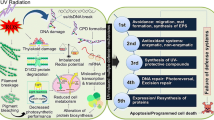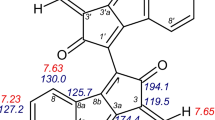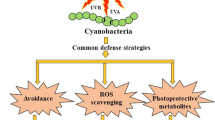Abstract
Scytonemin is a lipid-soluble, highly stable, yellow–brown-coloured secondary metabolite that is accumulated in the extracellular polysaccharide sheath of several but not all members of cyanobacteria. Chemically, scytonemin is an indole alkaloid composed of two heterocyclic units symmetrically connected through a carbon–carbon bond. Thus, scytonemin is unique among natural products due to its special structure, location in a cell, as well as strong absorption maxima in UV-A in addition to the violet–blue region. Traditionally, scytonemin is a well-established photoprotective compound against ultraviolet radiation. Its accumulation in the cyanobacterial sheath has been suggested to be a strategy adopted by several cyanobacteria to protect their cellular components against damaging effects of UVR. Additionally, recent studies have also established the importance of scytonemin in reactive oxygen species scavenging as well as in controlling the growth of cancerous cells. Thus, scytonemin is both ecologically as well as pharmaceutically important metabolite. Recent developments made in the biochemistry and genetics of this compound have paved the way for its application and commercialization for human welfare. This review aims to present a brief history of the compound with chronological developments made in the study of scytonemin and emphasizes its physiochemistry, analytical chemistry, biochemistry, and genetics. We provide a separate section for metabolic engineering and potential applications of scytonemin, mainly as sunscreen and anti-cancerous drugs. We also discuss the future research directions which need to be worked out.




Similar content being viewed by others
References
Garcia-Pichel F, Castenholz RW (1991) Characterization and biological implications of scytonemin, a cyanobacterial sheath pigment. J Phycol 27:395–409
Pathak J, Sonker AS, Richa R et al (2017) Screening and partial purification of photoprotective pigment, scytonemin from cyanobacteria dominated biological crusts dwelling on the historical monuments in and around Varanasi, India. Microbiol Res (Pavia) 8:6559
Fleming ED, Castenholz RW (2007) Effects of periodic desiccation on the synthesis of the UV-screening compound, scytonemin, in cyanobacteria. Environ Microbiol 9:1448–1455
Fleming ED, Castenholz RW (2008) Effects of nitrogen source on the synthesis of the UV screening compound, scytonemin, in the cyanobacterium Nostoc punctiforme PCC 73102. FEMS Microbiol Ecol 63:301–308
Balskus EP, Case RJ, Walsh CT (2011) The biosynthesis of cyanobacterial sunscreen scytonemin in microbial mat communities. FEMS Microbiol Ecol 77:322–332
Büdel B, Karsten U, Garcia-Pichel F (1997) Ultraviolet-absorbing scytonemin and mycosporine-like amino acid derivatives in exposed, rock-inhabiting cyanobacterial lichens. Oecologia 112(2):165–172
Garcia-Pichel F, Sherry ND, Castenholz RW (1992) Evidence for an ultraviolet sunscreen role of the extracellular pigment scytonemin in the terrestrial cyanobacterium Chlorogloeopsis sp. Photochem Photobiol 56:17–23
Proteau PJ, Gerwick WH, Garcia-Pichel F et al (1993) The structure of scytonemin, an ultraviolet sunscreen pigment from the sheaths of cyanobacteria. Experientia 49:825–829
Simeonov A, Michaelian K (2017) Properties of cyanobacterial UV-absorbing pigments suggest their evolution was driven by optimizing photon dissipation rather than photoprotection. Biol Phys 1–38. arXiv:1702.03588 [physics.bio-ph]
Matsui K, Nazifi E, Hirai Y et al (2012) The cyanobacterial UV-absorbing pigment scytonemin displays radical scavenging activity. J Gen Appl Microbiol 58:137–144
Richter PR, Sinha RP, Häder D-P (2006) Scytonemin-rich epilithic cyanobacteria survive acetone treatment. Curr Trends Microbiol 2:13–19
Garcia-Pichel F, Lombard J, Soule T et al (2019) Timing the evolutionary advent of cyanobacteria and the later great oxidation event using gene phylogenies of a sunscreen. mBio 10(3):e00561-19
Stevenson CS, Capper EA, Roshak AK et al (2002) The identification and characterization of the marine natural product scytonemin as a novel antiproliferative pharmacophore. J Pharm Exp Ther 303:858–866
Zhang G, Zhang Z, Liu Z (2013) Scytonemin inhibits cell proliferation and arrests cell cycle through down regulating Plk1 activity in multiple myeloma cells. Tumor Biol 34:2241–2247
Malla S, Sommer MOA (2014) A sustainable route to produce the scytonemin precursor using Escherichia coli. Green Chem 16:3255–3265
Rajneesh R, Singh SP, Pathak J et al (2017) Cyanobacterial factories for the production of green energy and value-added products: an integrated approach for economic viability. Renew Sustain Energy Rev 69:578–595
Chandra R, Iqbal HM, Vishal G et al (2019) Algal biorefinery: a sustainable approach to valorize algal-based biomass towards multiple product recovery. Bioresour Technol 278:346–359
D’Agostino PM, Woodhouse JN, Liew HT et al (2019) Bioinformatic, phylogenetic and chemical analysis of the UV-absorbing compounds scytonemin and mycosporine-like amino acids from the microbial mat communities of Shark Bay, Australia. Environ Microbiol 21(2):702–715
Edwards HG, Sadooni F, Vítek P et al (2010) Raman spectroscopy of the Dukhan sabkha: identification of geological and biogeological molecules in an extreme environment. Philos Trans R Soc A Math Phys Eng Sci 368:3099–3107
Nägeli C (1849) Gattungen einzelliger algen, physiologisch und systematisch bearbeitet. Neue Denkschr. Allg Schweiz Ges Ges Naturwiss 10:1–138
Nägeli C, Schwenderer S (1877) Das Mikroskop, 2nd edn. Willhelm Engelmann Verlag, Leipzig, p 505
Balskus EP, Walsh CT (2010) The genetic and molecular basis for sunscreen biosynthesis in cyanobacteria. Science 329:1653–1656
Kim S, Thiessen PA, Bolton EE et al (2016) PubChem substance and compound databases. Nucleic Acids Res 44(D1):D1202–D1213
Bultel-Poncé V, Félix-Théodose F, Sarthou C et al (2004) New pigments from the terrestrial cyanobacterium Scytonema sp. collected on the Mitaraka Inselberg, French Guyana. J Nat Prod 67:678–681
Varnali T, Edwards HGM (2010) Ab initio calculations of scytonemin derivatives of relevance to extremophile characterization by Raman spectroscopy. Philos Trans R Soc A Math Phys Eng Sci 368:3099–3107
Grant CS, Louda JW (2013) Scytonemin-imine, a mahogany-colored UV/Vis sunscreen of cyanobacteria exposed to intense solar radiation. Org Geochem 65:29–36
Varnali T, Edwards HGM (2014) Reduced and oxidised scytonemin: theoretical protocol for Raman spectroscopic identification of potential key biomolecules for astrobiology. Spectrochim Acta A 117:72–77
Helms GL, Moore RE, Niemczura WP et al (1988) Scytonemin A, a novel calcium antagonist from a blue-green alga. J Org Chem 53:1298–1307
Lepot K, Compère P, Gérard E et al (2014) Organic and mineral imprints in fossil photosynthetic mats of an East Antarctic lake. Geobiology 12:424–450
Naurin S, Bennett J, Videau P (2016) The response regulator Npun_F1278 is essential for scytonemin biosynthesis in the cyanobacterium Nostoc punctiforme ATCC 29133. J Phycol 52:564–571
Sinclair C, Whitton BA (1977) Influence of nutrient deficiency on hair formation in the rivulariaceae. Br Phycol J 12:297–313
Rath J, Mandal S, Adhikary SP (2012) Salinity induced synthesis of UV-screening compound scytonemin in the cyanobacterium Lyngbya aestuarii. J Photochem Photobiol B Biol 115:5–8
Kokabi M, Yousefzadi M, Soltani M et al (2019) Effects of different UV radiation on photoprotective pigments and antioxidant activity of the hot‐spring cyanobacterium Leptolyngbya cf. fragilis. Phycol Res. https://doi.org/10.1111/pre.12374
Soule T, Shipe D, Lothamer J (2016) Extracellular polysaccharide production in a scytonemin-deficient mutant of Nostoc punctiforme under UV-A and oxidative stress. Curr Microbiol 73:455–462
Soule T, Stout V, Swingley WD et al (2007) Molecular genetics and genomic analysis of scytonemin biosynthesis in Nostoc punctiforme ATCC 29133. J Bacteriol 189:4465–4472
Soule T, Palmer K, Gao Q et al (2009) A comparative genomics approach to understanding the biosynthesis of the sunscreen scytonemin in cyanobacteria. BMC Genom 10:336–345
Soule T, Garcia-Pichel F, Stout V (2009) Gene expression patterns associated with the biosynthesis of the sunscreen scytonemin in Nostoc punctiforme ATCC 29133 in response to UV-A radiation. J Bacteriol 191:4639–4646
Balskus EP, Walsh CT (2008) Investigating the initial steps in the biosynthesis of cyanobacterial sunscreen scytonemin. J Am Chem Soc 130:15260–15261
Balskus EP, Walsh CT (2009) An enzymatic cyclopentyl[b]indole formation involved in scytonemin biosynthesis. J Am Chem Soc 131:14648–14649
Matsui D, Asano Y (2019) Creation of thermostable L-tryptophan dehydrogenase by protein engineering and its application for L-tryptophan quantification. Anal Biochem 579:57–63
Gao Q, Garcia-Pichel F (2011) Microbial ultraviolet sunscreens. Nat Rev Microbiol 9:791–802
Rastogi RP, Sonani RR, Madamwar D (2015) Cyanobacterial sunscreen scytonemin: role in photoprotection and biomedical research. Appl Biochem Biotechnol 176:1551–1563
Mushir M, Fatma T (2012) Monitoring stress responses in cyanobacterial scytonemin-screening and characterization. Environ Technol 33:153–157
Dillon JG, Castenholz RW (1999) Scytonemin, a cyanobacterial sheath pigment, protects against UV-C radiation: implications for early photosynthetic life. J Phycol 35:673–681
Javor B, Castenholz RW (1984) Productivity studies of microbial mats, Laguna Guerrero Negro, Mexico. In: Cohen Y, Castenholz RW, Halvorsan H (eds) Microbial mats: stromatolites. Alan Liss Inc., New York, pp 149–170
Sinha RP, Klisch M, Vaishampayan A et al (1999) Biochemical and spectroscopic characterization of the cyanobacterium Lyngbya sp. inhabiting Mango (Mangifera indica) trees: presence of an ultraviolet-absorbing pigment, scytonemin. Acta Protozool 38:291–298
Rastogi RP, Incharoensakdi A (2014) Characterization of UV screening compounds, mycosporine-like amino acids, and scytonemin in the cyanobacterium Lyngbya sp. CU2555. FEMS Microbiol Ecol 87:244–256
Muehlstein L, Castenholz RW (1983) Sheath pigment formation in a blue green alga, Lyngbya aestuari, as an adaptation to high light. Biol Bull 165:521–522
Dodds WK (1989) Photosynthesis of two morphologies of Nostoc parmelioides as related to current velocities and diffusion patterns. J Phycol 25:258–262
Chen J, Zhao L, Xu J et al (2013) Determination of oxidized scytonemin in Nostoc commune Vauch cultured on different conditions by high performance liquid chromatography coupled with triple quadrupole mass spectrometry. J Appl Phycol 25:1001–1007
Itoh T, Koketsu M, Yokota N et al (2014) Reduced scytonemin isolated from Nostoc commune suppresses LPS/IFNc-induced NO production in murine macrophage RAW264 cells by inducing hemeoxygenase-1 expression via the Nrf2/ARE pathway. Food Chem Toxicol 69:330–338
Ehling-Schulz M, Bilger W, Scherer S (1997) UV-B induced synthesis of photoprotective pigments and extracellular polysaccharides in the terrestrial cyanobacterium Nostoc commune. J Bacteriol 179:1940–1945
Dodds WK, Castenholz RW (1988) The nitrogen budget of an oligotrophic cold water pond. Arch Hydrobiol Suppl 79:343–362
Rastogi RP, Sinha RP, Incharoensakdi A (2013) Partial characterization, UV-induction and photoprotective function of sunscreen pigment, scytonemin from Rivularia sp. HKAR-4. Chemosphere 93:1874–1878
Asencio AD, Hoffmann L (2013) Chemosystematic evaluation of the genus Scytonema (Cyanobacteria) based on occurrence of phycobiliproteins, scytonemin, carotenoids and mycosporine-like amino acid compounds. Eur J Phycol 48:331–344
Rastogi RP, Kumari S, Richa, Han T et al (2012) Molecular characterization of hot spring cyanobacteria and evaluation of their photoprotective compounds. Can J Microbiol 58:719–727
Rastogi RP, Incharoensakdi A, Madamwar D (2014) Responses of a ricefield cyanobacterium Anabaena siamensis TISTR-8012 upon exposure to PAR and UV radiation. J Plant Physiol 171:1545–1553
Castenholz RW (1984) Composition of hot-spring microbial mats: a summary. In: Cohen Y, Castenholz RW, Halvorsan H (eds) Microbial mats: stromatolites. Alan R. Liss, Inc., New York, pp 101–119
Ferreira D, Garcia-Pichel F (2016) Mutational studies of putative biosynthetic genes for the cyanobacterial sunscreen scytonemin in Nostoc punctiforme ATCC 29133. Front Microbiol 7:735
Janssen J, Soule T (2016) Gene expression of a two-component regulatory system associated with sunscreen biosynthesis in the cyanobacterium Nostoc punctiforme ATCC 29133. FEMS Microbiol Lett 363:1–6
Klicki K, Ferreira D, Hamill D et al (2018) The widely conserved ebo cluster is involved in precursor transport to the periplasm during scytonemin synthesis in Nostoc punctiforme. mBio 9:e02266-18
Yurchenko T, Ševčíková T, Strnad H et al (2016) The plastid genome of some eustigmatophyte algae harbours a bacteria-derived six-gene cluster for biosynthesis of a novel secondary metabolite. Open Biol 6(11):160249
Edwards HGM, Garcia-Pichel F, Newton EM et al (2000) Vibrational Raman spectroscopic study of scytonemin, the UV-protective cyanobacterial pigment. Spectrochim Acta 56:193–200
Squier AH, Airs RL, Hodgson DA et al (2004) Atmospheric pressure chemical ionisation liquid chromatography/mass spectrometry of the ultraviolet screening pigment scytonemin: characteristic fragmentations. Rapid Commun Mass Spectrom 18:2934–2938
Itoh T, Tsuzuki R, Tanaka T et al (2013) Reduced scytonemin isolated from Nostoc commune induces autophagic cell death in human T-lymphoid cell line Jurkat cells. Food Chem Toxicol 60:76–82
Whitehead K, Hedges JI (2002) Analysis of mycosporine-like amino acids (MAAs) in aquatic plankton by liquid chromatography electrospray-ionization mass spectrometry. Mar Chem 80:27–39
Varnali T, Gören B (2018) Two distinct structures of the sandwich complex of scytonemin with iron and their relevance to astrobiology. Struct Chem 29:1565–1572
Edwards HGM, Hutchinson I, Ingley R (2012) The ExoMars Raman spectrometer and the identification of biogeological spectroscopic signatures using a flight-like prototype. Anal Bioanal Chem 404:1723–1731
Venckus P, Paliulis S, Kostkevičiene J et al (2018) CARS microscopy of scytonemin in cyanobacteria Nostoc commune. J Raman Spectrosc 49:1333–1338
Soule T, Garcia-Pichel F (2014) Ultraviolet photoprotective compounds from cyanobacteria in biomedical applications. In: Sharma NK, Rai AK, Stal LJ (eds) Cyanobacteria: an economic perspective. Wiley, Chichester, pp 119–143
Acknowledgements
J. Pathak (09/013/0515/2013-EMR-I) and A. Pandey (09/013/0619/2016-EMR-I) are thankful to the Council of Scientific and Industrial Research, New Delhi, India. Rajneesh is grateful to Department of Biotechnology, Govt. of India, (DBT-JRF/13/AL/143/2158), for the grant in the form of senior research fellowships. P.K. Maurya (3616/NET-DEC2014) is thankful to University Grant commission (UGC), New Delhi, India, for financial support in the form of JRF. S.P. Singh acknowledges the UGC for start-up Grant (F.30-370/2017; BSR) and DST-SERB for early career research Award (ECR/2016/000578).
Author information
Authors and Affiliations
Contributions
JP and SPS conceptualized the idea, did the literature survey, and wrote the paper; Rajneesh, AP, and PM developed the figures and tables; and RPS and SPS edited the manuscript.
Corresponding author
Ethics declarations
Conflict of interest
The authors declare no conflict of interest to publish this manuscript.
Additional information
Publisher's Note
Springer Nature remains neutral with regard to jurisdictional claims in published maps and institutional affiliations.
Significance Statement This review highlights the recent advancements made in the study of a cyanobacterial photoprotective compound called scytonemin. The biochemistry and genetics of scytonemin production have been discussed in detail. The roadmap for scytonemin production using metabolically engineered strains and rate-limiting steps for scytonemin biosynthesis have been presented. Also, it emphasizes the various application of scytonemin in different industries for human welfare.
Rights and permissions
About this article
Cite this article
Pathak, J., Pandey, A., Maurya, P.K. et al. Cyanobacterial Secondary Metabolite Scytonemin: A Potential Photoprotective and Pharmaceutical Compound. Proc. Natl. Acad. Sci., India, Sect. B Biol. Sci. 90, 467–481 (2020). https://doi.org/10.1007/s40011-019-01134-5
Received:
Revised:
Accepted:
Published:
Issue Date:
DOI: https://doi.org/10.1007/s40011-019-01134-5




